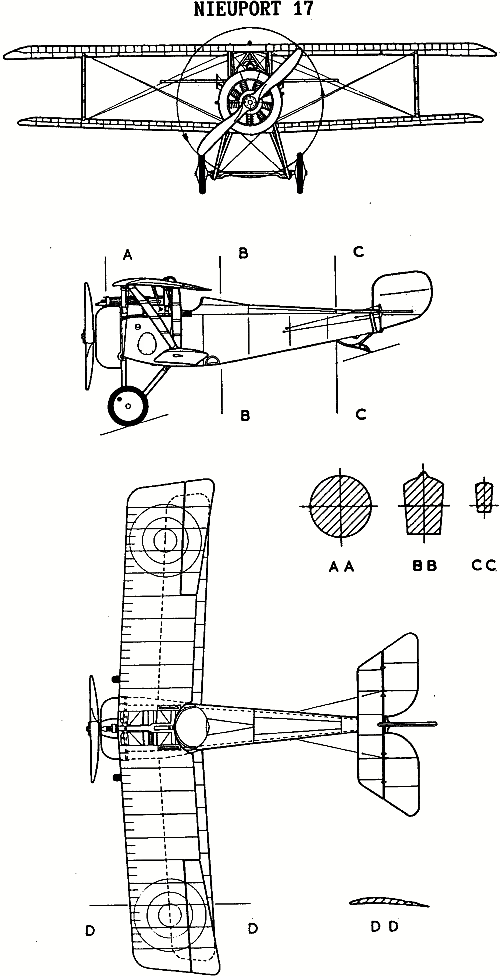Nieuport 17 History
Appearing on the Western Front on March 1916, the Nieuport 17 was a progressive development of the Nieuport 11 and Nieuport 16 single-seaters, and was to become the most successful and famous of all the Nieuport fighters to serve in the 1914-18 war.
The Nieuport 17 retained the 110 h.p. Le Rhône used in the Nieuport 16, differing chiefly from earlier Nieuports in having wings of increased span and area. Because of this, it was often called the Nieuport “15°” or “15-metre”, which was the approximate area of the new wings. The Nieuport 11’s single-spar lower wings had been liable to twist when the aircraft was dived or maneuvered tightly, and a stronger spar was therefore fitted to the Nieuport 17.
In service, the Nie.17 became one of the most successful and popular fighting aircraft of the entire war, both for its flying qualities and its fighting ability. In days when premier fighter pilots could virtually choose their own mounts, the inclusion of names like Ball, Bishop, Boyau, Guynemer, and Nungesser among those who flew the little Nieuport is its own recommendation. It had a fine view from the 138 cockpit, was a first-class dog-fighter, and, in the words of Commander C. R. Samson, R.N.A.S., climbed ‘like a witch’. It also had a reputation for ‘balloon-busting’ with Le Prieur rockets. Early Nieuport 17s fought with a Lewis gun on a Foster mounting over the top centre-section, but a single synchronized Vickers replaced this on later machines. Individual experiments were made with twin-gun installations, but these were found to impose an unacceptable performance penalty,
First French unit to receive the Nieuport 17 was Escadrille N.57 on 2 May 1916; other French escadrilles included N.3, N.38, N.55, N.65 and N.103. British Nieuport 17s joined their French comrades in service within weeks, eventually serving with Nos. 1, 2, 3, 6, 8, 9, 10, and 11 Squadrons R.N.A.S. and Nos. 1, 29, 32, 40, and 60 Squadrons R.F.C. on the Western Front. The type was also used by the R.F.C. in Macedonia. The number in British service is indeterminate: only eighty-nine known serial numbers (all for R.F.C. machines) apply specifically to Nieuport 17s, but this was clearly a fraction of the overall total. One authority quotes a figure of five hundred and twenty-seven Nieuport 11/17s in R.F.C./R.N.A.S. service, most of which would have been 17s. One hundred and fifty Nieuport 17s were built in Italy by Macchi; it was built in, and served in, Russia; twenty were supplied to the Dutch Army Air Service in 1917, others to the Belgian Aviation Militaire, and two to Finland. Seventy-six were purchased by the AEF as pursuit trainers. In August 1917, there were still three hundred and seventeen Nieuport 17s in front-line French service.
Late-production aircraft with 130 h.p. Clerget 9 B engines were designated Nieuport 17bis. The Nieuport 21 was a 2-seater trainer conversion with an 80 h.p. Le Rhône: one hundred and ninety-eight were sold to the United States in 1917-18. The Nieuport 23, built for French, British, and American use, had improved streamlining and tail surfaces similar to those that appeared later on the Nieuport 28. Some Nieuport 23s were sold after the war to the Swiss Fliegertruppe, and several single- and 2-seaters became sporting or privately owned aircraft in the days of peace. The success of the Nieuport fighters, and the Nieuport 17 in particular, was maintained even against the theoretically superior Albatros D.I and the early Halberstadt fighters, and it is no small tribute to the French machines that later German fighters were designed on instructions that they should incorporate many of the features that had made the Nieuports so outstanding.
Nieuport 17 Specifications
| Country: |
| France |
| Manufacturer: |
| Nieuport |
| Aircraft Type: |
| Fighter |
| Dimensions: |
| Wingspan: 26 ft 9 in |
| Length: 19 ft 0 in |
| Height: 7 ft 10 in |
| Weights: |
| Empty: 827 lb |
| Gross: 1,235 lb |
| Power plant: |
| 1 × Le Rhône 9Ja 9-cylinder rotary engine, 82 kW (110 hp) |
| Performance: |
| Maximum speed: 110 mph, 92 kn |
| Ceiling: 17,400 ft |
| Endurance: 1.75 hours |
| Armament: |
| (French service) 1 × synchronised 7.7 mm (.303 in) Vickers machine gun and/or 1 × 7.7 mm (.303 in) Lewis gun on upper wing |
| (British service) 1 × Lewis gun on Foster mounting on upper wing |
| Rockets: 8 × Le Prieur rockets |
| Operational Use: |
| 1916-1918 |










